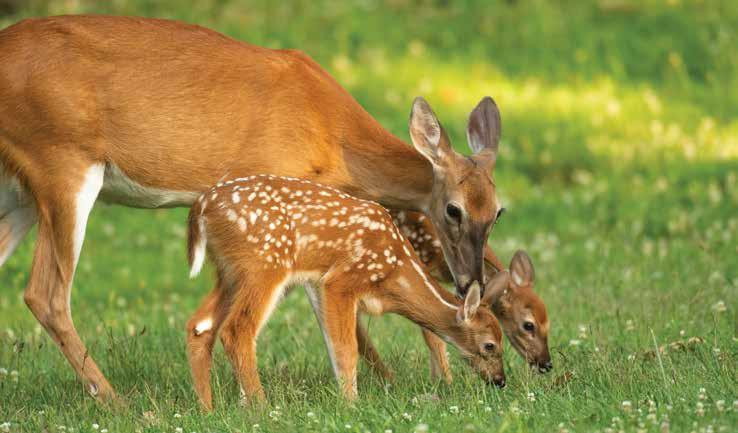
3 minute read
Deer 411
People in the New River Valley are fortunate to live in an area surrounded by robust wildlife. However, it is important to be educated on the best practices for sharing a habitat with these wonderful creatures and how to coexist safely.
Ticks and icks
Advertisement
If you spend any time in the woods, or even just in tall grasses, you need to be aware of ticks. With the warming climate, we are seeing tick activity year round, including ticks that can hardly be seen with the naked eye and carry and transmit diseases like Lyme and Rickettsia. Pets often carry these pests indoors unknowingly, flinging them onto carpets and furniture as they rub and scratch. Having dogs and cats on flea and tick medicine is an essential part of keeping pets and people safe.
If you see a tick that has embedded, carefully remove it with tweezers, trying to get the head of the tick with it. Cleansing the area with alcohol afterward can cut down on tickborne diseases drastically. People who get Lyme disease often do not remember seeing a tick, so keep an eye out for the tell-tale bulls-eye rash. If you see this type of rash, it’s wise to go to a doctor and get on doxycycline, stat.
Driving tips
It is almost as common to see a deer carcass on the side of the road as it is to see a squirrel in some parts of the NRV. High speed collisions with deer can be fatal – for deer and people. Not only can a deer come through the windshield and strike the driver or passenger, but if the driver slams the brakes prior to impact, the front of the car can dip down and launch the deer into the air and pose a threat to other drivers.
Some drivers have ample time to slow down and avoid a collision with a deer. But if you don’t spot the deer until it is too late, it can be better to brace yourself for impact than to hard brake or swerve at a high speed. Deer are more active and near roads at or around dawn and dusk.
Feed or no
Deer are getting less and less fearful of humans with every passing day. Many will come and eat right out of your hand! Even though this experience can be amazing, it is not a good idea to feed deer. Chronic Wasting Disease (CWD) is on the rise in deer, and because the disease is so contagious, feeding deer accelerates the spread of CWD because it causes deer to congregate.
Feeding young deer can also create problems, especially male deer or stags. When bucks enter puberty, they get rather feisty, and without a healthy fear of humans, they may engage someone in a “duel” once their antlers come in! This never ends well for the human.
When to call
If you see a deer that appears injured or sick, or a fawn that seems to have lost its mother, the best course of action is to leave the deer alone and quickly call the SWVA Wildlife Center, (540) 798-9836. If you follow your heartstrings and “rescue” a baby deer, the mother may reject the deer once it has been touched by humans (like with birds). Oftentimes these young fawns are perfectly fine - and mama is just around the corner foraging for food. It is also good to know that fawns like to lie in the middle of the road sometimes because the warm asphalt feels good on their skin. You may gently guide them out of the road using a stick, etc. so they are not in danger but try to avoid touching them, as tempting as it may be.

The hunt
The Virginia Department of Wildlife Resources is the perfect place to find out anything and everything you could ever care to know about hunting deer. There are important laws regarding when to hunt, what to hunt (does/bucks/size), how many deer per season, who can hunt (age limits) and what weapons are legal for hunting. These laws vary vastly by area, so be sure you are reading the right info for your location. Even topics like what to wear and whether or not your dogs can join you are covered.
Hunters play a vital role in keeping the deer population under control. Deer are getting smarter about staying away from places where they can be legally hunted, finding their way onto private lands and into neighborhoods where they can only be hunted with permission from the property owner. This might explain the lengths hunters are having to go to bag a deer, like camouflage, tree stands and boatloads of patience.
Once you do “bag a buck”, as they say, know in advance what to do with it. Make sure you have helpers for loading and you know of a reputable deer processing center nearby -- or do it yourself if you’re so inclined. Deer meat (venison) is a wonderful local food resource, and many hunters who have more than enough donate to local food banks.
NRV-based freelance writer Emily K. Alberts thinks we should all try switching to venison for Thanksgiving! It’s good AND good for you, and a great way to keep our local deer population under control.









